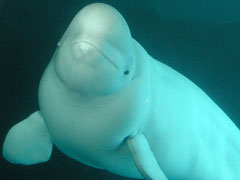Belugas
Belugas are able to thrive in both marine and estuarine environments. Delphinapterus leucas - the scientific name for beluga whales, means “white dolphin without a wing.” Along with the narwhal, belugas are part of the Monodontidae cetaecean family that lack a prominent snout and dorsal fin, and are native to Arctic waters.
Belugas feed primarily on arctic cod, arctic ciscoes, squid, shrimp and marine worms. Belugas in captivity are known to eat 10 to 15 kilograms of food per day (2.5 to 3% of their body weight).
Belugas' bodies have adapted over time to the harsh arctic environment.
Belugas are the only whales with flexible neck vertebrae. They can turn their heads to look for food, for danger, and at each other. Belugas have a dorsal ridge instead of a dorsal fin to be able to move under ice without injury to a fin and to conserve heat (that would be lost from a dorsal fin). The hard ridge can also be used to break thin ice to create breathing spaces.
The beluga's most prominent feature, its bulbous head, houses the melon organ that is used for echolocation.
